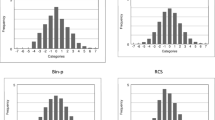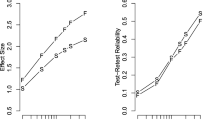Abstract
A computerized block design task was developed which records temporal and nontemporal measures of performance. This study evaluates the reliability of the measures and reports their intercorrelations. With one exception, the measures showed moderate to good reliability. The results indicate that increasing the difficulty of the task and testing a more diverse sample may be necessary for improved reliability. A nontemporal method of scoring a block-design task would be useful when testing persons who have handicaps affecting motor skills, but no central nervous system deficits.
Similar content being viewed by others
References
Apple Computer. (1988).HaperCard script language guide: The HyperTalk language. Reading, MA: Addison-Wesley.
Cohen, J.C., Montague, P., Nathanson, L.S., & Swerdlik, M.E. (1988).Psychological testing: An introduction to tests and measurement. Mountain View, CA: Mayfield.
Martin, T.A., & Wilcox, K.L. (1989). HyperCard administration of a block design task.Behavior Research Methods, Instrumentation, and Computers, 21, 312–315.
Wechsler, D. (1981).WAIS-R manual. San Antonio, TX: Psychological Corporation.
Author information
Authors and Affiliations
Rights and permissions
About this article
Cite this article
Martin, T.A. Nontemporal measures of performance on a computerized block design task. Current Psychology 11, 236–240 (1992). https://doi.org/10.1007/BF02686843
Issue Date:
DOI: https://doi.org/10.1007/BF02686843




